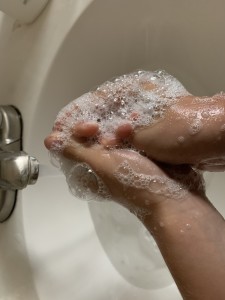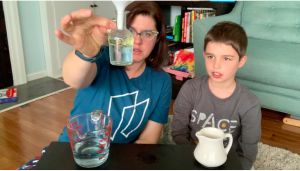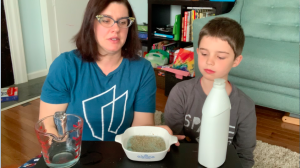Like everyone else, the question of connection looms large during this pandemic. Connection with patrons, connecting ideas – how to provide these meaningful experiences remotely? Especially STEAM for a young audience. When so much of the learning is experiential, how can we can reach our patrons? I have a glass half full (depending on the day) situation wherein I have two naturally curious, creative, youngsters at home, one of whom (my son Desi) is willing to be on camera. While this provides its own set of challenges (filming with my children is akin to trying to get an eager cat to follow instructions), I consider myself very lucky to be able to spend time learning with them. I also believe that my son provides a level of engagement and credibility for young people that I cannot offer as an adult. The giggle fits are worth it.
The first thing video that Desi and I shot was a one-off. I was struggling with finding ways to feel professionally effective from home while coping with my own feelings of powerlessness and fear in the face of the pandemic. My kids were struggling with their own feelings, new routines, and I can only imagine their own feelings of helplessness in the face of universal uncertainty. I decided to focus on something that we can control: hand washing. “Wash your hands” was the refrain at the library, the kids’ schools, really, everywhere we went. It was our mantra at home, but when my youngest asked “UGH WHY d o we have to do this so much?” I wanted to have a good answer to give her. Our family was also struggling with screen fatigue and scheduling chaos with all of us working and schooling from home. I knew I wanted to create something light and fun, that families could access on their own terms on their own schedules. Thus, the Saponify! video was born.
o we have to do this so much?” I wanted to have a good answer to give her. Our family was also struggling with screen fatigue and scheduling chaos with all of us working and schooling from home. I knew I wanted to create something light and fun, that families could access on their own terms on their own schedules. Thus, the Saponify! video was born.
First, Desi and I learned how soap is made. There are actually a number of different ways to make soap, but we focused on what is perhaps the most common: the combination of a fatty acid – this can be animal tallow, or a plant-based oil, and lye. This marriage creates a chemical reaction called saponification, and from this, we get soap.
So how does soap work? In my daughter’s eyes, water is the key ingredient, because it washes anything gross down the drain. What she didn’t understand is human skin secretes natural oils, and anyone who has ever made salad dressing knows that oil and water don’t play nicely together. Dirt and germs bond to the oils on your hands. You can rinse your hands forever, but that action is never going to do what you want it to. Adding soap, however, breaks up the oil bonds and allows the dirt and germs to be washed down the drain. So, every time you lather up and rinse, you’re doi ng chemistry!
ng chemistry!
I think this is a very exciting concept, and i wanted a cool visual to go along with with it. Something that would really drive the hand washing message home. What we ended up with in the video illustrates the essence of this specific concept rather than the exact letter, but it’s such a great visual, and such a fun experiment that it felt like a good fit.
For this experiment, you need a bowl, some water, some soap, and a dark colored spice (we used some expired marjoram that I found in the back of a cabinet. Hello, 2012!). Add some water to the bowl, then sprinkle your spice to the surface of the water. Observe that you can stir it or otherwise move the water, and the spice just stays put. Add a little soap to the water, however, and watch the spice zoom away.
As I  mentioned above (as well as in the video), this reaction is actually caused by a change in the surface tension of the water – not by soap breaking the oil bonds. It’s an incredible visual, though, and a great way to get the conversation going, both about soap chemistry, and the importance of personal hygiene.
mentioned above (as well as in the video), this reaction is actually caused by a change in the surface tension of the water – not by soap breaking the oil bonds. It’s an incredible visual, though, and a great way to get the conversation going, both about soap chemistry, and the importance of personal hygiene.
One challenge we faced in making this video was technical logistics. I was excited to learn a new skill, and filming on my iPhone was easy enough, but was not familiar with editing technology. We didn’t have access to the equipment or staff that we would normally have in the library, so we had to get creative. With this in mind, it seemed that the easiest option for streamlining and ease of production would be to shoot the entire video in one take. Filming what ultimately turned out to be a six minute video with a nine-year-old co-host and no teleprompter in one go was…not easy. That aside, I’m proud of what we made, and it laid the framework for my future STEAM-at-home video programming.




Leave A Comment